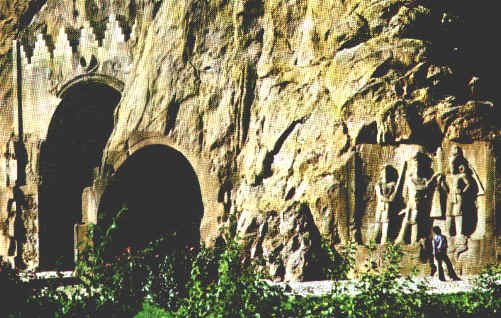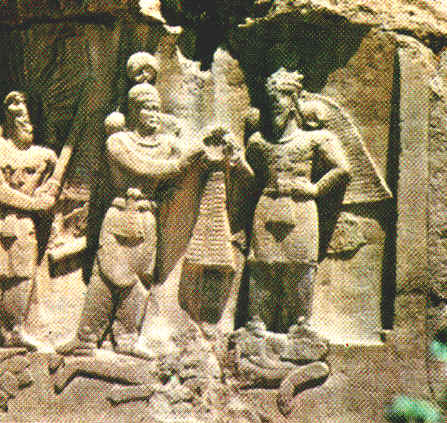|
|
32 km from Kermanshah is "Mountain of Gods", venerated by the ancient Persians and chosen by Darius, the Great to tell his story in a sort of picture-book for all ages.
Set on the cliff-face over 60 m above ground, Darius relief has for 25 centuries remained inaccessible to all, but the most enterprising.
Relief shows Darius with one foot on the defeated Gaumata, and facing long line of royal prisoners. The inscriptions try to establish Darius' legitimacy as the descendant of Cyrus the Great and the subsequent battles against various usurpers. Gaumata was the chief pretender and on the losing side in Darius' 19th and last battle.
This obviously major historical document of Achaemenian times is however so inaccessible, even to the eye, that binoculars are needed for proper appreciation.
On the way up to the closest vantage point for the famous relief, there are two Partian relieves, one of Mithradates II (100 BC) and the other of Gotarzes II (50 AD) on horseback and lancing enemy, both badly mutilated by 18th century work.
Right by the road, East of the relief, is the improbable figure of 148 BC Hercules, reclining Bachus fashion, and adding seemingly lighter touch to all the goings-on of the ancient world.
A little West and around the corner from Darius' masterpiece, Khosro II (depicted at Taq Bostan) took over broad expanse of the mountainside 955 by 200 m) for what would no doubt have been the biggest single bas-relief in the world. The project, however, stopped at the smoothing stage with the sudden death of the king in 928 AD.
The nearby "Donkey Cave" was inhabited up to 35,000 years ago.
Also of interest in the countryside stretching South of the road, where Safavid bridge and the remains of an older Sassanid one cross the river "Gamas Ab".
Directly opposite the relief are old caravanserai and the rough outlines of ancient settlement. Beyond the sugar mill and by the road is "Scared Spring".


Bisotoun: Bas-Relief
|
|


